Merthyr Tydfil, Wales, UK 作者: 来源: 发布时间:2021-09-18
I. Population and Area
Continent: Europe
Country: The U.K
State/Province: Wales
City/Town: Merthyr Tydfil
Total Area: 42.86 (sq mi)
Population in 2011: 43.82 (thousand)
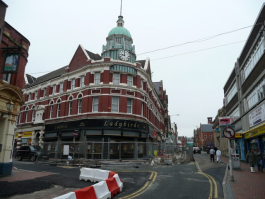
II. Natural Geography (environment and resources)
The "Pen-y-Darren" locomotive
In 1802, Homfray, the Master of the Penydarren Ironworks, commissioned engineer Richard Trevithick to build built one of his high-pressure steam engines to drive a hammer at the Penydarren Ironworks. With the assistance of works engineer Rees Jones, Trevithick mounted the engine on wheels and turned it into a locomotive. In 1803, Trevithick sold the patents for his locomotives to Homfray.
Homfray was so impressed with Trevithick's locomotive that he made another bet with Crawshay, this time for 500 guineas, that Trevithick's steam locomotive could haul 10 tons of iron along the Merthyr Tydfil Tramroad from Penydarren (51°45′03″N 3°22′33″W) to Abercynon (51°38′44″N 3°19′27″W), a distance of 9.75 miles (15.69 km). Amid great interest from the public, on 21 February 1804 it successfully carried 11.24 tons of coal, five wagons and 70 men over the full distance, in 4 hours and 5 minutes, at an average speed of 2.4 mph (3.9 km/h). As well as Homfray, Crawshay, and the passengers, other witnesses included Mr. Giddy, a respected patron of Trevithick, and an 'engineer from the Government'. The latter was probably a safety inspector, who would have been particularly interested in the boiler's ability to withstand high steam pressures. This opened the way for others to develop Trevithick's ideas and the railway as we know it today can rightly claim to have been born in Merthyr Tydfil.
In modern Merthyr, behind the monument to Trevithick's locomotive, is a stone wall, which is the sole remainder of the former boundary wall of Penydarren House. There is a full-scale working replica of Trevithick's 1804 steam-powered railway locomotive in the National Waterfront Museum, Swansea.
Roads
Road improvements mean the town is increasingly a commuter location and has shown some of the highest house price growth in the UK.
Public transport
Regular trains services operate from Merthyr Tydfil railway station to Cardiff Queen Street and Cardiff Central. Merthyr Tydfil bus station is located on Castle Street to the north of the town centre. In 2019 building started on a new bus station on the site of the former police station in Swan Street, which was scheduled to open in 2020. The new bus station will be located closer to the railway station to facilitate passenger interchange as part of the proposed South Wales Metro network.
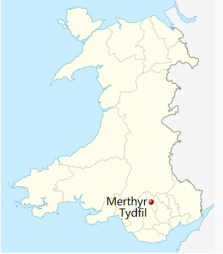
III. ECONOMY
1.1 This paper addresses data regarding economic trends over the immediate period. The economic trend data has been presented without the corresponding labour market data which will be addressed by Social Regeneration. It is important to remember that influencing this macro data is both extremely difficult and it is also very difficult to evidence direct impact from economic development services from within the council. Reflecting this, the key performance indicators used and presented relate to local indicators that are specific to individual programmes delivered through Economic Development. This is also true of the projected targets presented which are based on the locally delivered programmes.
1.2 In 2011, there were 1,360 VAT and/or PAYE based enterprises in Merthyr Tydfil. 87% of these employed less than 20 people. This highlights the importance of small companies to the local economy. There were 95 enterprise births in Merthyr Tydfil and 145 enterprise closures. The rate of business births and closures in Merthyr Tydfil as a proportion of working age population is the same as the rates for Wales. Date Written 21/08/14 Report Author Alyn Owen Service Area Economic Development Committee Date 1/09/14
1.3 The Service Sector is the largest employer in Merthyr Tydfil. In 2008, the Service Industry provided 79.9% of jobs, the Manufacturing Sector was the second largest with 16.7% and Construction and other provided 2.8%. Within the service sector public administration is the largest employer with 39.3% of jobs which is above the Welsh average of 32.9%.
1.4 The breakdown of employment by sector shows that there is a lower proportion of jobs in professional occupations in Merthyr Tydfil than in Wales. The main occupational areas in Merthyr Tydfil are the Elementary Occupations (17.1%) which are those jobs that consist of simple and routine tasks which mainly require the use of hand tools and often some physical effort, with the Associate Professional and Technical Occupations, Administrative and Secretarial Occupations and Skilled Trades & Occupations, each of which account for 12% each of the population working in these sectors.
1.5 Gross Value Added (GVA) is a measure of the size of the economy of an area, GVA per head in 2007 stood at £11,604 in Merthyr Tydfil. This was below the Welsh average of £14,853 and the fifth lowest amongst the 22 Welsh local authorities. Between 1999 and 2007 GVA per head in Merthyr Tydfil has been below that for Wales as a whole.
1.6 In 2012, the average gross earnings in Merthyr Tydfil were £432.70 per week, this compares to the Wales average of £503.10
The average per head in Wales increased to £16,341 for 2015, according to the Office for National Statistics (ONS). But the country also saw the largest growth in household income of the UK nations with a rise of 3.3%. For the first time, the figures are also broken down for local authorities. It shows Newport has the highest GDHI in Wales at £18,410 per head. Blaenau Gwent has the lowest with £12,878 which is also the fourth lowest of local council areas in the UK.
Flintshire ranks second highest in Wales with £18,280 per head, above Cardiff on £18,137. We should be careful when trying to speculate as to exactly why both Newport and Flintshire are ahead of the Welsh capital on these provisional figures. But they are close to the Bristol commuting area and northern powerhouse respectively. Both have also attracted their fair share of new industries. At the county level, Ceredigion saw the highest growth - 6.3% - while the lowest with 1.6% was in Merthyr Tydfil, where the GDHI is £15,821 per head.
The local area with the lowest in the UK is Nottingham with £12,779 and the highest is again in the London area of Kensington, Chelsea, Hammersmith and Fulham with £52,298 per head. Wales' GDHI per head figure is 85.5% of the UK figure - a slight narrowing of the gap of 0.3% - although it has not been this low since the late 1990s. When nations and English regions are looked at, the income per head figure is still lower than Wales in Northern Ireland, Yorkshire and Humberside and the north east of England.
Reference Website:
https://www.bbc.com/news/uk-wales-40001100
https://democracy.merthyr.gov.uk/documents/s23771/ECONOMIC%20DEVELOPMENT%20OVERVIEW.pdf
IV. Industrial Characterisitics
Major industries:
Merthyr was close to reserves of iron ore, coal, limestone, lumber and water, making it an ideal site for ironworks. Small-scale iron working and coal mining had been carried out at some places in South Wales since the Tudor period, but in the wake of the Industrial Revolution the demand for iron led to the rapid expansion of Merthyr's iron operations. By the peak of the revolution, the districts of Merthyr housed four of the greatest ironworks in the world: Dowlais, Plymouth, Cyfarthfa and Penydarren. The companies were mainly owned by two dynasties, the Guest and Crawshay families. The families supported the establishment of schools for their workers.
Starting in the late 1740s, land within the Merthyr district was gradually being leased for the smelting of iron to meet the growing demand, with the expansion of smaller furnaces dotted around South Wales. By 1759, with the management of John Guest, the Dowlais Ironworks was founded. This would later become the Dowlais Iron Company and also the first major works in the area. Following the success at Dowlais, Guest took a lease from the Earl of Plymouth which he used to build the Plymouth Ironworks. However, this was less of a success until the arrival in 1763 of a "Cumberland ironmaster, Anthony Bacon, who leased an area of eight miles by five for £100 a year on which he started the Cyfarthfa Ironworks and also bought the Plymouth Works". After the death of Anthony Bacon in 1786, the ownership of the works passed to Bacon's sons, and was divided between Richard Hill, their manager and Richard Crawshay. Hill now owned the Plymouth Iron Works and Crawshay the works at Cyfarthfa. The fourth ironworks was Penydarren, built by Francis Homfray and his son Samuel Homfray in 1784.
It was the need to export goods from Cyfarthfa that led to the construction of the Glamorganshire Canal running from their works right down the valley to Cardiff Bay, stimulating other enterprises along the way.
During the first few decades of the 19th century, the ironworks at Cyfarthfa (and neighbouring Dowlais) continued to expand, and at their height they were the most productive ironworks in the world. 50,000 tons of rails left just one ironworks in 1844, for the railways across Russia to Siberia. With the growing industry in Merthyr, several railway companies established routes linking the works with ports and other parts of Britain. They included the Brecon and Merthyr Railway, Vale of Neath Railway, Taff Vale Railway and Great Western Railway. They often shared routes to allow access to coal mines and ironworks through rugged country, which presented great engineering challenges. According to David Williams, in 1804, the world's first railway steam locomotive, "The Iron Horse", developed by the Cornish engineer Richard Trevithick, pulled 10 tons of iron with passengers on the new Merthyr Tramroad from Penydarren to Quakers Yard. He also claims that this was the "first 'railway' and the work of George Stephenson was merely an improvement upon it". A replica of this locomotive is in the National Waterfront Museum in Swansea. The tramway passed through what is arguably the oldest railway tunnel in the world, part of which can be seen alongside Pentrebach Road at the lower end of the town. The demand for iron was also fuelled by the Royal Navy, which needed cannon for its ships, and later by the railways. In 1802, Admiral Lord Nelson visited Merthyr to witness cannon being made.
Famously, upon visiting Merthyr in 1850, Thomas Carlyle wrote that the town was filled with such "unguided, hard-worked, fierce, and miserable-looking sons of Adam I never saw before. Ah me! It is like a vision of Hell, and will never leave me, that of these poor creatures broiling, all in sweat and dirt, amid their furnaces, pits, and rolling mills.
Major projects and related introductions:
There’s no denying regeneration and investment in Merthyr Tydfil has transformed the borough in recent years. Today, an almost fully let Cyfarthfa Retail Park is nearly always busy, Rhydycar was redeveloped to become the popular Merthyr Tydfil Leisure Village, and Penderyn Square and Redhouse Cymru provide perfect venues for cultural events like Merthyr Rising and local festivals.
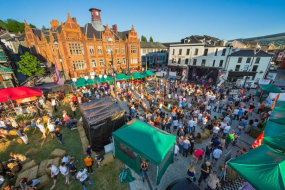
Looking ahead, there are still major regeneration schemes under way, or in the pipeline, worth millions of pounds – which, it’s hoped, will cement Merthyr’s position as a somewhat regional centre of the South Wales Valleys, blending culture, history, retail, transport infrastructure and leisure to regenerate the area.
Unlike the current bus station, the new one would be locked at night, have a police presence – after the police station was relocated out-of-town – and there is set to be a taxi rank at the site. It is expected the current taxi rank will also remain where it is, on Victoria Street in the town centre, to continue serving customers in that part of town.
Relocating the bus station to Swan Street – a few minutes’ walk away from its current site just off Castle Street – would see its links with Merthyr Tydfil railway station improve.
Reference Website:
https://www.walesonline.co.uk/business/business-news/full-details-major-projects-could-13278426
V. Attractions
1. Become a history buff at Cyfarthfa Castle:
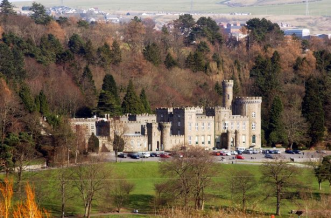
Probably Merthyr's most iconic landmark, the castle is home to a museum and art gallery that tells the story of Merthyr from the Roman times through to the late 20th Century and also exhibits dresses by Merthyr born Laura Ashley and Julien McDonald.
2. Have a picnic at Cyfarthfa park:

While away the day at the beautiful grounds of Cyfartha castle. Catch it on a sunny day and you'll have the perfect surroundings to throw down a blanket and a basket full of food and drinks.
3. Shoot down the flume at Merthyr Leisure Centre:
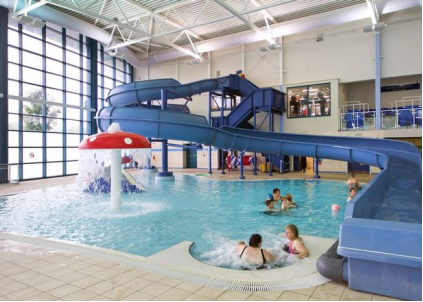
Whether you need to entertain the kids or just fancy being a big kid yourself, the popular slide at Merthyr Leisure Centre is a must. Or if it's not your thing, you can always just go for a dip.
Reference Website:
https://www.walesonline.co.uk/whats-on/whats-on-news/merthyr-bucket-list-50-things-11617104
VI. History
Pre-history
Peoples migrating north from Europe had lived in the area for many thousands of years. The archaeological record starts from about 1000 BC with the Celts. From their language, the Welsh language developed. Hillforts were built during the Iron Age and the tribe that inhabited them in the south of Wales was called the Silures, according to Tacitus, the Roman historian of the Roman invaders.
The Roman invasion
The Romans arrived in Roman Wales by about 47–53 AD and established a network of forts, with roads to link them. They had to fight hard to consolidate their conquests, and in 74 AD they built an auxiliary fortress at Penydarren, overlooking the River Taff. It covered an area of about three hectares, and formed part of the network of roads and fortifications; remains were found underneath the football ground where Merthyr Town F.C. play. A road ran north–south through the area, linking the southern coast with Mid Wales and Watling Street via Brecon. Parts of this and other roads, including Sarn Helen, can be traced and walked.
The Silures resisted this invasion fiercely from their mountain strongholds, but the Romans eventually prevailed. In time, relative peace was established and the Penydarren fortress was abandoned by about 120 AD. This had an unfortunate effect upon the local economy, which had come to rely upon supplying the fortress with beef and grain, and imported items such as oysters from the coast. Intermarriage with local women had occurred and many auxiliary veterans had settled locally on farms.
With the Decline of the Roman Empire, Roman legions were withdrawn around 380 AD. By 402 AD, the army in Britain comprised mostly Germanic troops and local recruits, and the cream of the army had been withdrawn across to the continent of Europe. Sometime during this period, Irish Dalriadan (Scots) and Picts attacked and breached Hadrian's Wall. During the 4th and 5th centuries the coasts of Cambria (Wales) had been subject to the raids of Irish pirates, in much the same way as the south and east coasts of Britain had been raided by Saxon pirates from across the North Sea. Around the middle of the 5th century, Irish settlements had been established around Swansea and the Gower Peninsula and in Pembrokeshire and eventually petty kingdoms were established as far inland as Brecon. By about 490 AD hordes of Saxons invaded and settled in the east or "lowland" Britain and the locals were left to their own devices to fight off these new invaders.
The coming of Christianity
The Latin language and some Roman customs and culture became established before the withdrawal of the Roman army. The Christian religion was introduced throughout much of Wales by the Romans, but locally it may have been introduced later by monks from Ireland and France, who made their way into the region following rivers and valleys.
Local legends
Local tradition holds that a girl called Tydfil, daughter of a local chieftain named Brychan, was an early local convert to Christianity, and was pursued and murdered by a band of marauding Picts and Saxons while travelling to Hafod Tanglwys in Aberfan, a local farm that is still occupied. The girl was considered a martyr after her death in around 480 AD. "Merthyr" translates to "Martyr" in English, and tradition holds that, when the town was founded, the name was chosen in her honour. A church was eventually built on the traditional site of her burial.
The Normans
For several hundred years the valley of the River Taff was heavily wooded, with a few scattered farms on the mountain slopes. Norman barons moved in after the Norman Conquest of England, but by 1093 they occupied only the lowlands; the uplands remained in the hands of the local Welsh rulers. There were conflicts between the barons and the families descended from the Welsh princes, and control of the land passed to and fro in the Welsh Marches. During this time Morlais Castle was built two miles north of the town.
Early modern Merthyr
No permanent settlement was formed until well into the Middle Ages. People continued to be self-sufficient, living by farming and later by trading. Merthyr was little more than a village. An ironworks existed in the parish in the Elizabethan period, but it did not survive beyond the early 1640s at the latest. In 1754, it was recorded that the valley was almost entirely populated by shepherds. Farm produce was traded at a number of markets and fairs, notably the Waun Fair above Dowlais.
VII. Culture
The town has held many cultural events. Local poets and writers hold poetry evenings in the town, and music festivals are organised at Cyfarthfa Castle and Park. With this in mind, Menter Iaith Merthyr Tudful (the Merthyr Tydfil Welsh Language Initiative) has successfully transformed the Zoar Chapel and the adjacent vestry building in Pontmorlais into a community arts venue, Canolfan Soar and Theatr Soar, which run a whole programme of performance events and activities in both Welsh and English, together with a cafe and book shop, specialising in local interest and Welsh language books and CDs. Also on Pontmorlais, Merthyr Tydfil Housing Association was successful in a number of funding bids to develop the Old Town Hall into a new cultural centre, working in partnership with Canolfan a Theatr Soar to turn the Pontmorlais area into a cultural quarter. The Old Town Hall facility was launched on Saint David's Day 2014 as an arts centre. With references to the 1831 Merthyr Rising and the building's red bricks, the venue has been named Redhouse Cymru. Merthyr Tydfil College's Arts and Media departments occupy part of the building, holding occasional professional performances at Redhouse's Dowlais Theatre and providing opportunities for students to perform dance, musicals, plays, and instrumental and vocal concerts.
Merthyr Tydfil has several choirs. Dowlais Male Voice Choir, Ynysowen Male Voice Choir, Treharris Male Voice Choir, Merthyr Tydfil Ladies Choir, Con Voce, Cantorion Cyfarthfa, St David's Church Choir, St David's Choral Scholars, Merthyr Aloud and Tenovus. These choirs perform locally, around the world and in the media. Merthyr has several historical and heritage groups:
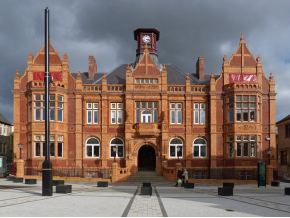
The Merthyr Tydfil Heritage Regeneration Trust, which has as its aim – "To preserve for the benefit of the residents of Merthyr Tydfil and of the Nation at large whatever of the Historical, Architectural and Constructional Heritage may exist in and around Merthyr Tydfil in the form of buildings and artefacts of particular beauty or of Historical, Architectural or Constructional interest and also to improve, conserve and protect the environment thereto."
The Merthyr Tydfil Historical Society, which has as its aim – "To advance the education of the public by promoting the study of the local history and architecture of Merthyr Tydfil". The Merthyr Tydfil Museum and Heritage Groups, which has as its aim – "To advance the education of the public by the promotion, support and improvement of the Heritage of Merthyr Tydfil and its Museums."
Merthyr's Central Library, which is in a prominent position in the centre of the town, is a Carnegie library. Merthyr hosted the National Eisteddfod in 1881 and 1901 and the national Urdd Gobaith Cymru Eisteddfod in 1987.
Merthyr, like nearby Aberdare, is known for its thriving music scene. The town has produced several bands that have achieved national success, including The Blackout and Midasuno. From 2011–14 the town held the Merthyr Rock Festival at Cyfarthfa Park. To complement this, the town now holds the Merthyr Rising each year - a three day celebration of the town's history through local music which is held on the site of the Rising itself in Penderyn Square at the junction of Castle Street and High street.
VIII. Other information
Anglican churches
Merthyr was regarded as a nonconformist stronghold in the 19th century, but the chapels declined rapidly from the 1920s onwards and most are now closed.
The Church did, however, seek to counterbalance the influence of nonconformity in the 19th century, and Merthyr had a succession of notable clergymen as parish priests. Among them was John Griffith, rector of Merthyr from 1858 until his death in 1885. Griffith had previously been the incumbent at Aberdare where he had created controversy for his evidence to the commissioners preparing the 1847 Education Reports. His views became more tempered over time however. Griffith's move to Merthyr Tydfil saw him take over a much larger and more established parish than Aberdare. He became less than popular with the church authorities, however, as a result of his support for disestablishment. In July 1883 he stated "I have been for years convinced that nothing but Disestablishment, the separation of the Church from the State, can ever reform the Church in Wales."
Griffith's funeral was said to have been attended by between 12,000 and 15,000 people. "I venture to declare," wrote one correspondent, "no man in this part of the kingdom could be more popular in his day and generation than the Rev. John Griffith." Among the nonconformist ministers present at the funeral was his old rival, Dr Thomas Price of Aberdare.
Another influential character is Sir John Guest, who contributed greatly to the building of St. John's Church, which was named after its founder and benefactor. Despite the generally small congregations of Anglican churches, St John's thrived: it held two services each Sunday, two services in English and also two in Welsh. This church was significant in the plan to counterbalance nonconformity in Merthyr. However, there are now plans for its conversion to residential flats which will retain its original structure.
Nonconformity
Merthyr was notable in the nineteenth and early twentieth centuries for a large number of nonconformist places of worship, most of which held services in the Welsh language. One of the earliest chapels was Ynysgau, which dated back to 1749. The chapel was unfortunately demolished in 1967 as part of the Merthyr Town Improvement Scheme. The original cause at Ynysgau was established by various ‘dissenters’ from the Church of England and it was acquired by the Independents (Congregationalists) by the early nineteenth century. Other early chapels were Zion and Ebenezer (Baptists), Zoar and Bethesda (Independents) and Pontmorlais (Calvinistic Methodists).
The Merthyr Hebrew Congregation
Merthyr Tydfil had the largest Jewish community in Wales in the 19th century: at its height there were around 400 Jewish people living in the town. As the Jewish population had increased, the Merthyr Hebrew Congregation was founded in 1848 and a cemetery consecrated a few years later at Cefn-Coed. The Merthyr synagogue was built in 1875. The Jewish community has now gone from the town. Religious services stopped when it had a male Jewish population of under 10 men, the minyan (quorum) for religious services. In the 1980s the 120-year-old synagogue was put up for sale and it became a Christian Centre and then a gym. In 2009 permission was granted for the former synagogue to be turned into flats.
IX. Contact information
Mayor/Officer: Howard Barrett
Tel: 01685 725000
Mail: customer.care@merthyr.gov.uk
Reference Website:
https://www.merthyr.gov.uk/council/mayor/the-mayor/about-the-mayor/
